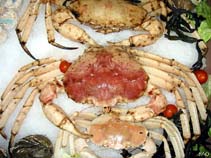Chaceon fenneri (Manning & Holthuis, 1984)
Golden deepsea crab| Native range | All suitable habitat | Point map | Year 2050 |

|
| This map was computer-generated and has not yet been reviewed. |
| Chaceon fenneri AquaMaps Data sources: GBIF OBIS |
Classification / Names Tên thường gặp | Các synonym ( Các tên trùng) | CoL | ITIS | WoRMS
Malacostraca | Decapoda | Geryonidae
Environment: milieu / climate zone / Mức độ sâu / distribution range Sinh thái học
; Mức độ sâu 200 - 2002 m (Tài liệu tham khảo 101759). Deep-water; 7°C - 16°C; 38°N - 23°N, 88°W - 64°W
Distribution Các nước | Các khu vực của FAO | Các hệ sinh thái | Những lần xuất hiện | Những chỉ dẫn
Western Atlantic: South Atlantic Bight, the Gulf of Mexico and Bermuda.
Length at first maturity / Bộ gần gũi / Weight / Age
Chín muồi sinh dục: Lm ?, range 9 - 16.9 cm Max length : 19.0 cm CW con đực/không giới tính; (Tài liệu tham khảo 101836); Khối lượng cực đại được công bố: 2.0 kg (Tài liệu tham khảo 101836)
Short description Hình thái học
Life cycle and mating behavior Chín muồi sinh dục | Sự tái sinh sản | Đẻ trứng | Eggs | Sự sinh sản | Larvae
Main reference
Các tài liệu tham khảo | Người điều phối | Người cộng tác
Tavares, M. 2003 True Crabs. pp. 327-352. In Carpenter, K.E. (ed.) The living marine resources of the Western Central Atlantic. Volume1: introdution, molluscs, crustaceans, hagfishes, sharks, batoid fishes, and chimaeras. FAO Species Identification Guide for Fishery Purposes and American Society of Ichthyologists and Herpetologists Special PublicationNo. 5. Rome, FAO. pp. 1-600. (Tài liệu tham khảo 367)
IUCN Red List Status
(Tài liệu tham khảo 130435: Version 2025-1)
CITES status (Tài liệu tham khảo 108899)
CMS (Tài liệu tham khảo 116361)
Threat to humans
Human uses
Các nghề cá: Tính thương mại
| FishSource |
Các công cụ
Thêm thông tin
Thành phần thức ăn
Thành phần thức ăn
Các động vật ăn mồi
Max. ages / sizes
Length-weight rel.
Length-length rel.
Length-frequencies
Mass conversion
Sự phong phú
Các nguồn internet
BHL | BOLD Systems | CISTI | DiscoverLife | FAO(Publication : search) | Fishipedia | GenBank (genome, nucleotide) | GloBI | Gomexsi | Google Books | Google Scholar | Google | PubMed | Cây Đời sống | Wikipedia (Go, tìm) | Tạp chí Zoological Record



